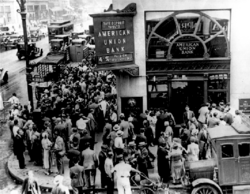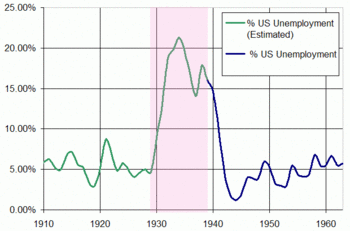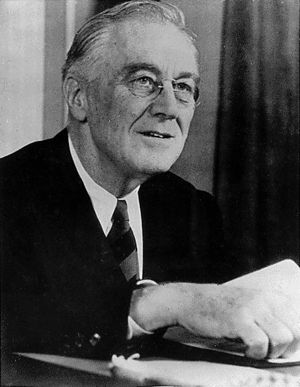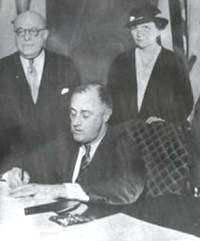نيو ديل

أعلى اليمين: فرانكلين دلانو روزڤلت، كان مسئولاً عن مبادرات وبرامج المعروفة إجمالاً باسم نيو ديل.
الوسط: ملصق للعامة لأحد الفنانين العاملين في نيو ديل.
| جزء من سلسلة مقالات عن |
| التقدمية |
|---|
| أفكار |
| التاريخ |
نيو ديل New Deal، كانت سلسلة من البرامج المحلية التي أطلقت في الولايات المتحدة بين عامي 1933 و1938. تضمنت قوانين أعدها الكونگرس أثناء الفترة الرئاسية الأولى للرئيس فرانكلين روزڤلت. جاءت تلك البرامج استجابة للكساد الكبير وتركزت على ما يسميه المؤرخون الألفات الثلاثة وهي: "الإغاثة والإنعاش والإصلاح". وتشير تلك النقاط الثلاث إلى إغاثة العاطلين والفقراء، وإنعاش الاقتصاد إلى مستوياته الطبيعية، وإصلاح النظام المالي لمنع حدوث الكساد مرة أخرى.
نجحت نيو ديل في إجراء تصحيحات سياسية، وترجيح القوة السياسية للحزب الديمقراطي (فضلًا عن توليه رئاسة البيت الأبيض لسبع فترات رئاسية من أصل عشر فترات من عام 1933 إلى عام 1969)، وذلك بفضل الأفكار الليبرالية التي تعتمد عليها تلك البرامج فضلاً عن اعتمادها على سكان الجنوب البيض والديمقراطيين التقليديين وعمال مصانع المدن والنقابات العمالية المُنشأة الحديثة والأقليات العرقية. وانقسم الجمهوريون تجاه تلك البرامج، فبعضهم وهم محافظون عارضوا نيو ديل بأكملها بوصفها عدواً للعمل والنمو، والآخرون وهم الليبراليون قبلوا بعضها ووعدوا بتحسين كفاءتها. وتبلورت هذه التصحيحات في ائتلاف نيو ديل الذي استحوذ على أغلب الانتخابات الرئاسية في ستينيات القرن العشرين، في حين سيطر الائتلاف المحافظ المعارض إلى حد كبير على الكونگرس من عام 1937 وحتى عام 1963. كان يستخدم مصطلح "الليبرالية" بحلول عام 1936 عادة لمؤيدي الصفقة الجديدة، و"محافظة" لمعارضيها. ساعد حصول "المؤيدين للإنفاق" على أغلبية في الكونگرس روزفلت في مساعيه من عام 1934 إلى عام 1938. حصل ائتلاف الكونگرس "المؤيد للإنفاق" (مأخوذة من حزبين إضافة إلى المنافسين وغير الآليين والتقدميين ودوائر حزب اليسار) على أغلبية تقريبية في انتخابات عام 1934. ووفقًا لما لاحظه ألكسندر هيكس، وقع روزڤلت اتفاقية نيو ديل الثانية، مدعومًا بالأغلبية القليلة من الديمقراطيين غير الجنوبيين وكان ذلك بحضور 270 ممثلاً عن الديمقراطيين الجنوبيين و71 من أعضاء مجلس الشيوخ الديمقراطيين غير الجنوبيين.[1]
ويفرق كثير من المؤرخين بين اتفاقية "نيو ديل الأولى" (1933-1934) واتفاقية "نيو ديل الثانية" (1935-1938)، قائلين إن الثانية كانت أكثر تحررًا وإثارة للجدل. فقد تضمنت برنامج عمل وطني، وإدارة سير الأعمال (WPA)، وهذا البرنامج جعل الحكومة الفيدرالية إلى حد بعيد هي أكبر صاحب عمل في البلاد.[2] وتناولت اتفاقية "نيو ديل الأولى" (1933-1934) مجموعات متنوعة، بدءاً من الخدمات المصرفية والسكك الحديدية وحتى الصناعة والزراعة، وجميعها كان في حاجة إلى العون لتحقيق الانتعاش الاقتصادي. فعلى سبيل المثال قامت الإدارة الفيدرالية للإغاثة في حالات الطوارئ بتوفير 500 مليون دولار لمطاعم الفقراء ولأموال الإعانات.[3] واشتملت اتفاقية "نيو ديل الثانية" المبرمة عام 1935م-1938م على قانون فاغنر لتعزيز عمل النقابات العمالية وبرنامج إغاثة لإدارة سير الأعمال (WPA) وقانون الضمان الاجتماعي وبرامج جديدة لمساعدة المزارعين المستأجرين والعمال المهاجرين. وكانت البنود الرئيسة الأخيرة للتشريعات في اتفاقية نيو ديل الجديدة تنص على إنشاء هيئة إسكان بالولايات المتحدة وإدارة أمن المزارع في عام 1937 وإنشاء قانون معايير العمل العادل لعام 1938، الذي وضع ساعات الحد الأقصى والحد الأدنى للأجور بالنسبة لمعظم فئات العاملين.[4]
أدى الانكماش الاقتصادي في عامي 1937 و1938 والانقسام المرير بين النقابة العمالية لاتحاد العمل الأمريكي (AFL) ومؤتمر المنظمات الصناعية (CIO) إلى حصول الجمهوريين على مقاعد كثيرة في الكونگرس عام 1938. وفي الكونگرس اتحد المحافظون الجمهوريون مع الديمقراطيين تحت مظلة الائتلاف المحافظ غير الرسمي. وأغلق الجمهوريون في عامي 1942 و1943 برامج إغاثة منها إدارة سير الأعمال وسلك الخدمة المدنية (CCC) وحالوا دون تنفيذ مقترحات ليبرالية رئيسة. والتفت روزفلت نفسه إلى الاهتمام بالجهود الحربية، وأعيد انتخابه في عامي 1940 و1944. أعلنت المحكمة العليا عن تكوين الهيئة العليا للتنظيم (NRA) وإصدار نسخة أولى غير دستورية لتأسيس رابطة المحاسبة الأمريكية (AAA)، ومع ذلك أعيد كتابتها وتم إبرامها. وعندما جاء دوايت ايزنهاور (1953-1961)، أوقف نيو ديل بكاملها، بل ووسعها في بعض النطاقات، وذلك بوصفه أول رئيس جمهوري منتخب بعد فرانكلين روزڤلت.[5] وفي ستينيات القرن العشرين، اعتمدت برامج المجتمع العظيم التي قام بها ليندون جونسون على نيو ديل لتكون مصدر إلهام للتوسع الكبير في البرامج الليبرالية، التي أبقاها ريتشارد نيكسون. إلا أنه بعد عام 1974 كانت الدعوة إلى تحرير الاقتصاد التي حازت على قبول ودعم الحزبين.[6] وتم تعليق العمل بقوانين نيو ديل المنظمة للعمل المصرفي (قانون جلاس ستيجال) في تسعينيات القرن العشرين. ولا يزال يطبق العديد من برامج نيو ديل وبعضها يعمل بالاسم الأصلي له، ومن ذلك الشركة الفيدرالية لتأمين الودائع (FDIC) والمؤسسة الفيدرالية لتأمين المحاصيل (FCIC) وإدارة الإسكان الفيدرالية (FHA) وهيئة وادي تينيسي (TVA). وأضخم البرامج وجودًا في يومنا هذا هي نظام الضمان الاجتماعي وهيئة الأوراق المالية والتداول (SEC).
الأصول
الانهيار الاقتصادي (1929–1933)
من عام 1929 حتى 1933 إنخفض إنتاج التصنيع بمقدار الثلث.[7] إنخفضت الأسعار بنسبة 20%، مما أدى لحدوث تضخم الأمر الذي جعل تسديد الديون أكثر صعوبة. تزايدت البطالة في الولايات المتحدة من 4% إلى 25%.[8] بالإضافة إلى ذلك، ثلث الموظفين كانوا يعملون بدوام جزئي بأقل من رواتبهم بكثير. إجمالاً، حوالي 50% من القوى العاملة في البلاد كانت غير مستخدمة.[9]
قبل نيو ديل، لم يكن هناك تأمين على الودائع في البنوك.[10] عندما أغلقت آلاف البنوك، فقد المودعون (في المتوسط) 15% من مدخراتهم. في ذلك لاوقت لم يكن هناك شبكة ضمان وطنية، ولا تأمين ضد البطالة، ولا ضمان اجتماعي.[11] الإغاثة من الفقر كانت مسئولية العائلات، الجمعيات الخيرية الخاصة، والحكومات المحلية، لكن بعد أن ساءت الأمور عاماً بعد عام، إرتفع الطلب وتراجعت مواردهم المشتركة على نحو متزايد أقل بكثير من الطلب.[9]
دمر الكساد البلاد. عندما أدى روزڤلت اليمين على منصبه ظهيرة 4 مارس 1933، أغلق حكام الولايات كل البنوك في البلاد؛ لم يتمكن أي شخص من صرف شيك أو الحصول على مدخراته.[12] كان معدل البطالة حوالي 25% وأعلى من ذلك في المراكز الصناعية والتعدينية الكبرى. إنخفض دخل الحقول بأكثر من 50% منذ عام 1929. 844.000 من الرهون غير الزراعية تم منعها، 1930-33، بلغ مجموعات خمس مليون.[13] خشي الزعماء السياسيون ورجال الأعمال من الثورة والأناركية. جوسف پ. كندي، الأب، الذي ظل ثرياً أثناء الكساد، أعلن بعد سنوات أن "في تلك الأيام شعرت وقلت أنني على إستعداد للتخلي على نصف ما أملك إذا ما أمكنني التأكد من الإحتفاظ، بمقتضى قانون أو أمر، بالنصف الآخر".[14]
نيو ديل (1933–1938)
عند قبول مرشيح الرئاسي الديمقراطي عام 1937، وعد فرانكلين روزڤلت "بنيو ديل للشعب الأمريكي".[15][16]
جميع رجال ونساء الأمة، المنسيون في الفلسفة السياسية للحكومة، تطلعوا إلينا هنا من أجل أن تهتدوا ومن أكل المزيد من الفرص المتكافئة للمشارة في توزيع الثروة القومية...أتعقد بنيو ديل جديد للشعب الأمريكي. الأمر أكثر من كونه دعاية سياسية. إنها دعوة للأيدي.[17]
دخل روزڤلت مكتبه بدون رسم خطط محددة للتعامل مع الكساد الكبير، لذا فقد إرتجل كما إستمع الكونگرس لمجموعة واسعة من الأصوات.[18] من بينهم أكثر مستشاري روزڤلت شهرة و"موضع الثقة" غير الرسمي: مجموعة تميل إلى رأي يقضي بالتدخل الواقعي للحكومة في الاقتصاد على نحو إيجابي.[19] اختياره لوزيرة العمل، فرانسس پركينز، كان له تأثير كبير على مبادراته. قائمة أولوياتها إذا ما تولت مهمة تخطيط العمل: "أسبوع عمل من 40 ساعة، حد أدنى للأجور، تعويضات للعمال، تعويضات بطالة، قانون فدرالي يحظر عمالة الأطفال، مساعدة فدرالية مباشرة للإغاثة من البطالة، ضمان اجتماعي، تنشيط خدمة التوظيف العامة والتأمين الصحي."[20]
رسمت سياسات نيو ديل من العديد من الأفكار المختلفة التي أقترحت في أوائل القرن العشرين. مساعد المدعي العام ثورمان أرنولد قاد جهود أعادت للأذهان مرة أخرى تقليد مكافحة الإحتكار المتجذرة في السياسات الأمريكية عن طريق شخصيات مثل أندرو جاكسون وتوماس جفرسون. قاضي المحكمة العليا لويس برانديز، مستشار مؤثر على الكثير من أنصار نيو ديل، زعم أن "التضخم" (يشير، ويقصد، المؤسسات) كان قوة اقتصادية سلبية، أنتجت الضياع وعدم الكفاءة. ومع ذلك، فالجماعات المناهضة للإحتكار كان لها تأثير كبير على سياسة نيو ديل.[21] زعماء آخرون مثل هيو صمويل من حملة النسر الأزرق NRA أخذوا أفكار من ادارة وودرو جوسون، تقنيات دعوية كانت مستخدمة لحشد الاقتصاد من أجل الحرب العالمية الأولى. جاءوا بأفكار وخبرات من السيطرة الحكومية والإنفاق عام 1917–18. مخططون آخرون لنيو ديل أحيوا خبرات كانت قد إقترحت في العشرينيات، مثل هيئة وادي تنيسي TVA.
"نيو ديل الأولى" (1933-34) شملت مقترحات قدمها طيف واسع من المجموعات. (لم تشمل الحزب الاشتراكي، الذي كان all but destroyed.)[22] المرحلة الأولى من نيو ديل كانت تتميز أيضاً بالحفاظ المالي (انظر القانون الاقتصادي، أسفل المقال) والتجارب المختلفة المتعددة، وأحياناً المتناقضة لمواجهة العلل الاقتصادية. العواقب كانت متفاوتة. بعض البرامج، خاصة ادارة الإنعاش الوطني (NRA) والبرنامج الذهبي، كان ينظر إليها من قبل الكثيرين على أنها فاشلة.[23][24] البرامج الأخرى استمرت لحوالي عقد؛ بعضها أصبح دائم. أخذ الاقتصاد منحى تصاعدي، حيث أعتبرت فترة نيو ديل الأولى واحدة من أسرع الفترات لنمو الناتج المحلي الإجمالي في التاريخ. على الرغم من التراجع عام 1937-38 فقد ظهرت أسئلة حول مدى نجاح السياسات، الغالبية العظمى من الاقتصاديين والمؤرخين اتفقا على أنها كانت فترة مربحة على جميع المستويات.
واجه نيو ديل بعض أصوات المعارضة المحافظة. أول معارضة منظمة عام 1934 جاءت من اتحاد الحرية الأمريكي بزعامة الديمقراطيين المحافظين من أمثال مرشح الانتخابات الرئاسية 1924 و1928 جون ديڤيز وآل سميث. أيضاً كان هناك جماعات تابعة كبيرة لكنها متفرقة من المعارضين لنيو ديل، الذين عادة ما يطلق عليهم اليمين القديم. تضمنت هذه المجموعة سياسيين، مفكرين، كتاب، رؤساء تحرير صحف ومذاهب فلسفية مختلفة شملت الليبراليين الكلاسيكيين والمحافظين، وديمقراطيين وجمهوريين.
مثل نيو ديل تحول كبير في السياسة والسياسة المحلية. أدى ذلك بشكل خاص إلى تنظيم فدرالي متزايد للاقتصاد. شهد أيضاً بداية البرامج الاجتماعية المعقدة والسلطة المتنامية للنقابات العمالية. تأثير نيو ديل ظل مصدر للجدل والنقاش بين الاقتصاديين والمؤرخين.[25]
مقارنات عالمية
أوروپا
كندا والكاريبي
آسيا
أستراليا ونيوزيلاندا
نيو ديل الأول (1933–1934)
أول مائة يوم (1933)

السياسة المالية
إصلاح الصيرفة

الاصلاح النقدي
تنظيم الأوراق المالية
إلغاء الحظر
الإنعاش
الأعمال العامة

البرامج الزراعية والريفية
الإنعاش
حملة "النسر الأزرق"

قطاع الإسكان
الاصلاح
تحرير التجارة
پورتو ريكو
نيو ديل الثاني (1935–1938)
قانون الضمان الاجتماعي
علاقات العمل
إدارة تقدم الأشغال

السياسة الضريبية
قانون الإسكان 1937
Court-packing plan and jurisprudential shift
ركود 1937 والإنعاش

الحرب العالمية الثانية والبطالة الشاملة

ذكراه

تأريخ وتقييم سياسات نيو ديل
السياسة المالية
الإغاثة
الإنعاش
التفسير الكينزي
التفسير النقدي
النمو الاقتصادي والبطالة (1933-1941)
| معدل البطالة[27] | 1933 | 1934 | 1935 | 1936 | 1937 | 1938 | 1939 | 1940 | 1941 |
|---|---|---|---|---|---|---|---|---|---|
| عمال في برامج خلق فرص العمل يعدهم البرنامج عاطلين | 24.9% | 21.7% | 20.1% | 16.9% | 14.3% | 19.0% | 17.2% | 14.6% | 9.9% |
| عمال في برامج خلف فرص العمل يعدهم البرنامج عاملين | 20.6% | 16.0% | 14.2% | 9.9% | 9.1% | 12.5% | 11.3% | 9.5% | 8.0% |
التأثير على الكساد
الاصلاح
التأثير على الحكومة الفدرالية والولايات
العرق والنوع
الأفارقة الأمريكان
المرأة ونيو ديل
اتهامات
اتهامات بالفاشية
اتهامات بالمحافظة
الشيوعيون في الحكومة
الاستعارة السياسية
أعمال فنية وموسيقية

برامج نيو ديل
تضمن نيو ديل الكثير من البرامج والوكالات الجديدة، معظمها كان يعرف عالمياً بحروفه الأولى. معظم ألغيت أثناء الحرب العالمية الثانية؛ الأخرى ظلت تعمل حتى اليوم. هذه البرامج تشمل:
- الادارة الوطنية للشباب (NYA)
- مؤسسة تمويل إعادة الإعمار (RFC) وكالة Hoover والتي توسعت تحت ادارة جونز هولمان جونز لتمنع قروض أكبر للأعمال التجارية الكبرى. أغلقت عام 1954.
a Hoove

- الادارة الفدرالية لإغاثة الطوارئ (FERA) a Hoover program to create unskilled jobs for relief; expanded by FDR and Harry Hopkins; replaced by WPA in 1935.
- عطلة البنوك الأمريكية، 1933: تغلق جميع البنوك حتى يتم التصديق عليها من قبل المراجعين الفدراليين.
- التخلي عن معيار الذهب، 1933: احتياطي الذهب لم يعد عملة مدعومة؛ لا يزال قائم حتى الآن.
- قوات الحفاظ المدني (CCC)، 1933–1942: شباب تم توظيفهم لآداء أعمال لا تتطلب مهارات في المناطق الريفية؛ تحت إشراف الجيش الأمريكي؛ برامج منفصلة للأمريكان الأصليين.
- مؤسسة قروض ملاك المنازل (HOLC) تساعد الأشخاص في الإحتفاظ بمنازلهم، تحصل الحكومة على ملكيات من البنوك مما يسمح للأشخاص بالسداد للحكومة بدلاً من البنوك على أقساط بقدر إمكانياتهم، ليظل الأشخاص في منازلهم و banks afloat.
- هيئة وادي تنيسي (TVA)، 1933: جهد لتحديث الاقليم شديد الفقر (معظم تنيسي)، المتمركز حول الخزانات التي تستخدم لتوليد الكهرباء على نهر تنيسي؛ لا تزال موجودة.
- قانون الاصلاح الزراعي (AAA)، 1933: raised farm prices by cutting total farm output of major crops and livestock; replaced by a new AAA because the Supreme Court ruled it unconstitutional.
- قانون الإغاثة الصناعية الوطنية (NIRA)، 1933: industries set up codes to reduce unfair competition, raise wages and prices; ended 1935. The US Supreme Court ruled the NIRA unconstitutional
- ادارة الأشغال العامة (PWA)، 1933: built large public works projects; used private contractors (did not directly hire unemployed). Ended 1938.
- Federal Deposit Insurance Corporation (FDIC) insures bank deposits and supervises state banks; still exists
- قانون گلاس-ستيگال ينظم الصيرفة الاستثمارية، ألغي عام 1999
- قانون الأوراق المالية 1933، created the SEC, 1933: codified standards for sale and purchase of stock, required awareness of investments to be accurately disclosed; still exists
- ادارة الأعمال المدنية (CWA)، 1933–34: provided temporary jobs to millions of unemployed
- قانون إعادة التنظيم الهندي، 1934: moved away from assimilation; policy dropped
- قانون الضمان الاجتماعي (SSA)، 1935: يوفر إعانة مالية إلى: المسنين، المعاقين، paid for by employee and employer payroll contributions; required 7 years contributions, so first payouts were in 1942; still exists
- ادارة تقدم الأعمال (WPA)، 1935: a national labor program for more than 2 million unemployed; created useful construction work for unskilled men; also sewing projects for women and arts projects for unemployed artists, musicians and writers; ended 1943.
- القانون الوطني لعلاقات العمل (NLRA) / Wagner Act, 1935: set up National Labor Relations Board to supervise labor-management relations; In the 1930s, it strongly favored labor unions. Modified by the Taft-Hartley Act (1947); still exists
- مشروع قانون إعادة التنظيم القضائي، 1937: gave the President power to appoint a new Supreme Court judge for every judge 70 years or older; failed to pass Congress
- Federal Crop Insurance Corporation (FCIC), 1938: Insures crops and livestock against loss of production or revenue. Was restructured during the creation of the Risk Management Agency in 1996 but continues to exist.
- Surplus Commodities Program (1936); gives away food to poor; still exists as Food Stamp Program
- Fair Labor Standards Act 1938: established a maximum normal work week of 44 hours and a minimum wage of 40 cents/hour and outlawed most forms of child labor; still exists, hours have been lowered to 40 hours over the years.
- Rural Electrification Administration (REA), one of the federal executive departments of the United States government charged with providing public utilities (electricity, telephone, water, sewer) to rural areas in the U.S. via public-private partnerships. still exists.
- ادارة إعادة التنظمين (RA), Resettled poor tenant farmers; replaced by Farm Security Administration in 1935.
- Farm Security Administration (FSA), Helped poor farmers by a variety of economic and educational programs; some programs still exists as part of the Farmers Home Administration.
احصائيات
احصائيات الكساد
| 1929 | 1931 | 1933 | 1937 | 1938 | 1940 | |
|---|---|---|---|---|---|---|
| إجمالي الناتج القومي الحقيقي (GNP) (1) | 101.4 | 84.3 | 68.3 | 103.9 | 96.7 | 113.0 |
| مؤشر سعر المستهلك (2) | 122.5 | 108.7 | 92.4 | 102.7 | 99.4 | 100.2 |
| مؤشر الانتاج الصناعي (2) | 109 | 75 | 69 | 112 | 89 | 126 |
| Money Supply M2 (بليون دولار) | 46.6 | 42.7 | 32.2 | 45.7 | 49.3 | 55.2 |
| الصادرات (بليون دولار) | 5.24 | 2.42 | 1.67 | 3.35 | 3.18 | 4.02 |
| البطالة (% من قوى العمل المدني) | 3.1 | 16.1 | 25.2 | 13.8 | 16.5 | 13.9 |
- (1) عام 1929 دولار
- (2) 1935–39 = 100
| السنة | لبرگوت | داربي |
|---|---|---|
| 1933 | 24.9 | 20.6 |
| 1934 | 21.7 | 16.0 |
| 1935 | 20.1 | 14.2 |
| 1936 | 16.9 | 9.9 |
| 1937 | 14.3 | 9.1 |
| 1938 | 19.0 | 12.5 |
| 1939 | 17.2 | 11.3 |
| 1940 | 14.6 | 9.5 |
| 1941 | 9.9 | 8.0 |
| 1942 | 4.7 | 4.7 |
| 1943 | 1.9 | 1.9 |
| 1944 | 1.2 | 1.2 |
| 1945 | 1.9 | 1.9 |
- Darby counts WPA workers as employed; Lebergott as unemployed
- المصادر: الاحصائيات التاريخي للولايات المتحدة (1976) السلسلةD-86؛ سمايلي 1983[29]
إحصائيات الإغاثة
| 1936 | 1937 | 1938 | 1939 | 1940 | 1941 | |
|---|---|---|---|---|---|---|
| عمال موظفون: | ||||||
| WPA | 1,995 | 2,227 | 1,932 | 2,911 | 1,971 | 1,638 |
| CCC and NYA | 712 | 801 | 643 | 793 | 877 | 919 |
| Other federal work projects | 554 | 663 | 452 | 488 | 468 | 681 |
| حالات المساعدة العامة: | ||||||
| برامج الضمان الاجتماعي | 602 | 1,306 | 1,852 | 2,132 | 2,308 | 2,517 |
| الإغاثة العامة | 2,946 | 1,484 | 1,611 | 1,647 | 1,570 | 1,206 |
| إجمالي الأسر التي تم مساعدتها | 5,886 | 5,660 | 5,474 | 6,751 | 5,860 | 5,167 |
| عمال عاطلون (Bur Lab Stat) | 9,030 | 7,700 | 10,390 | 9,480 | 8,120 | 5,560 |
| التغطية (حالات/بطالة) | 65% | 74% | 53% | 71% | 72% | 93% |
انظر أيضاً
- أرثرديل، ڤرجينيا الغربية، تجمع خطط له نيو ديل.
- الليبرالية في الولايات المتحدة
- الليبرالية الحديثة في الولايات المتحدة
- نيو ديل والفنون في المكسيك
- خط زمني للكساد الكبير
- حالة الرفاة الأمريكية
عام:
المصادر
- ^ Social Democracy and Welfare Capitalism: A Century of Income Security Politics by Alexander Hicks
- ^ Alonzo L. Hamby (2004). For the Survival of Democracy: Franklin Roosevelt and the World Crisis of the 1930s. Simon and Schuster. p. 418.
- ^ Mastering Modern World History by Norman Lowe, second edition, P.117
- ^ Kennedy, Freedom from Fear (1999) ch 12
- ^ Roderick P. Hart (2001). Politics, Discourse, and American Society: New Agendas. Rowman & Littlefield. p. 46.
- ^ Martha Derthick, The Politics of Deregulation (1985), p. 5-8
- ^ A.E. Safarian (1970). The Canadian Economy. books.google.com. ISBN 9780773584358.
- ^ United States Bureau of Labor Statistics (January 30, 2003). "Compensation from before World War I through the Great Depression". bls.gov.
{{cite web}}: Unknown parameter|coauthors=ignored (|author=suggested) (help) - ^ أ ب Kennedy, Freedom From Fear (1999) p. 87
- ^ National Archives and Records Administration (1995). "Records of the Federal Deposit Insurance Corporation [FDIC]". archives.gov.
- ^ Mary Beth Norton; et al. (2009). A People and a Nation: A History of the United States. Since 1865. Cengage. p. 656. ISBN 0547175604.
{{cite book}}: Explicit use of et al. in:|author=(help) - ^ March 4 was a Saturday and banks were not open on weekends. On Monday FDR officially closed all banks. Arthur Schlesinger, Jr. The Coming of the New Deal (1959), p. 3; Brands, Traitor to his class (2008) p. 288.
- ^ Jonathan Alter, The Defining Moment: FDR's Hundred Days and the Triumph of Hope, esp. ch 31. (2007); Bureau of the Census, Historical Statistics of the United States (1977) series K220, N301.
- ^ Laurence Leamer (2001). The Kennedy Men: 1901–1963. HarperCollins. p. 86.
- ^ The phrase was perhaps borrowed from the title of Stuart Chase's book A New Deal published in February 1932 and serialized in the New Republic that summer. Gary Dean Best, Peddling panaceas: popular economists in the New Deal era (2005) p. 117
- ^ The phrase was also used by Gifford Pinchot in 1910, when he said, in a speech rallying young men to political action to remove special interests from politics, that "The people of the United States demand a new deal and a square deal." Address by Gifford Pinchot before the Roosevelt Club of St. Paul, Minnesota, June 11, 1910
- ^ "The Roosevelt Week", Time, New York, July 11, 1932
- ^ Leuchtenburg pp 33–35.
- ^ Leuchtenburg p. 58.
- ^ Downey, Kirstin (2009). The Woman Behind the New Deal; The Life of Frances Perkins, FDR's Secretary of Labor and His Moral Conscience. New York: Nan A. Talese, an imprint of The Doubleday Publishing Group, a division of Random House, Inc.,. p. 1. ISBN 978-0-385-51365-4.
{{cite book}}: CS1 maint: extra punctuation (link) - ^ Leuchtenburg p. 34.
- ^ Leuchtenburg p. 188.
- ^ Bernard Bellush, The Failure of the NRA (1975)
- ^ Arthur Crawford, Monetary management under the new deal (1940) p 240
- ^ Kennedy, Freedom From Fear (1999) p 364
- ^ Data was obtained from the U.S. Census Bureau, Statistical Abstract and converted into SVG format by me. The numbers come from this U.S. Census document, page 17, column 127. Note that the graph only covers factory employment.
- ^ Gene Smiley, "تقديرات معدلات البطالة الأخيرة في العشرينيات والثلاثينيات"، جريدة التاريخ الاقتصادي (1983) 43#2 ص. 487–93. In JSTOR
- ^ U.S. Dept of Commerce, National Income and Product Accounts Real GDP and GNP; Mitchell 446, 449, 451;Consumer Price Index AND M2 Money Supply: 1800–2003
- ^ Smiley, Gene, "Recent Unemployment Rate Estimates for the 1920s and 1930s", Journal of Economic History, June 1983, 43, 487–93.
قراءات إضافية
مسوحات
- Badger, Anthony J. The New Deal: The Depression Years, 1933–1940. (2002) general survey from British perspective
- Chafe, William H. ed. The Achievement of American Liberalism: The New Deal and its Legacies (2003)
- Conkin, Paul K. The New Deal. (1967), a brief New Left critique.
- Dubofsky, Melvyn, ed. The New Deal: Conflicting Interpretations and Shifting Perspectives. (1992), reader
- Eden, Robert, ed. New Deal and Its Legacy: Critique and Reappraisal (1989), essays by scholars
- Hiltzik, Michael. The New Deal: A Modern History (2011), popular history by journalist; 512pp
- Leuchtenburg, William E. Franklin D. Roosevelt and the New Deal, 1932–1940. (1963). A standard interpretive history.
- Kennedy, David M. "What the New Deal Did," Political Science Quarterly, 124 (Summer 2009), 251–68.
- Kennedy, David M. Freedom From Fear: The American People in Depression and War, 1929–1945. (1999), survey; Pulitzer Prize
- Kirkendall, Richard S. "The New Deal As Watershed: The Recent Literature", The Journal of American History, Vol. 54, No. 4. (Mar., 1968), pp. 839–852. in JSTOR, historiography
- McElvaine Robert S. The Great Depression 2nd ed (1993), social history
- Polenberg, Richard. "The Era of Franklin D. Roosevelt 1933–1945 A Brief History with Documents" ISBN 0-312-13310-3
- Schlesinger, Arthur M. Jr., The Age of Roosevelt, 3 vols, (1957–1960), the classic narrative history.
- Shlaes, Amity. The Forgotten Man: A New History of the Great Depression (2007)
- Sitkoff, Harvard. ed. Fifty Years Later: The New Deal Evaluated. (1984). A friendly liberal evaluation.
- Wecter, Dixon. The Age of the Great Depression, 1929–1941 (1948), social history
المراجع
- Beasley, Maurine H., Holly C. Shulman, Henry R. Beasley. The Eleanor Roosevelt Encyclopedia (2001)
- Brands, H.W. Traitor to His Class: The Privileged Life and Radical Presidency of Franklin Delano Roosevelt (2008)
- Charles, Searle F. Minister of Relief: Harry Hopkins and the Depression (1963)
- Cohen, Adam, Nothing to Fear: FDR's Inner Circle and the Hundred Days that Created Modern America (2009)
- Graham, Otis L. and Meghan Robinson Wander, eds. Franklin D. Roosevelt: His Life and Times. (1985). An encyclopedic reference.
- Ingalls, Robert P. Herbert H. Lehman and New York's Little New Deal (1975)
- Pederson, William D. ed. A Companion to Franklin D. Roosevelt (Blackwell Companions to American History) (2011); 35 essays by scholars; many deal with politics
اقتصاديات، مزارع، عمل، إغاثة
- Bernstein, Irving. Turbulent Years: A History of the American Worker, 1933–1941 (1970), cover labor unions
- Best, Gary Dean. Pride, Prejudice, and Politics: Roosevelt Versus Recovery, 1933–1938. (1990) ISBN 0-275-93524-8; conservative perspective
- Blumberg Barbara. The New Deal and the Unemployed: The View from New York City (1977).
- Bremer William W. "Along the American Way: The New Deal's Work Relief Programs for the Unemployed". Journal of American History 62 (December 1975): 636–652. in JSTOR
- Brock William R. Welfare, Democracy and the New Deal (1988), a British view
- Burns, Helen M. The American Banking Community and New Deal Banking Reforms, 1933–1935 (1974)
- Folsom, Burton. New Deal or Raw Deal? : How FDR's Economic Legacy has Damaged America (2008) ISBN 1-4165-9222-9, conservative interpretation
- Gordon, Colin. New Deals: Business, Labor, and Politics, 1920–1935 (1994)
- Grant, Michael Johnston. Down and Out on the Family Farm: Rural Rehabilitation in the Great Plains, 1929–1945 (2002)
- Hawley, Ellis W. The New Deal and the Problem of Monopoly (1966)
- Howard, Donald S. The WPA and Federal Relief Policy (1943)
- Huibregtse, Jon R. American Railroad Labor and the Genesis of the New Deal, 1919–1935; (University Press of Florida; 2010; 172 pages)
- Jensen, Richard J. "The Causes and Cures of Unemployment in the Great Depression", Journal of Interdisciplinary History 19 (1989) 553–83. in JSTOR
- Leff, Mark H. The Limits of Symbolic Reform: The New Deal and Taxation (1984)
- Lindley, Betty Grimes and Ernest K. Lindley. A New Deal for Youth: The Story of the National Youth Administration (1938)
- Mathews, Jane De Hart. "Arts and the People: The New Deal Quest for a Cultural Democracy", Journal of American History 62 (1975): 316–39, in JSTOR
- Malamud; Deborah C. "'Who They Are—or Were': Middle-Class Welfare in the Early New Deal" University of Pennsylvania Law Review v 151 No. 6 2003. pp 2019+.
- McKinzie, Richard. The New Deal for Artists (1984), well illustrated scholarly study
- Meriam; Lewis. Relief and Social Security The Brookings Institution. 1946. Highly detailed analysis and statistical summary of all New Deal relief programs
- Mitchell, Broadus. Depression Decade: From New Era through New Deal, 1929–1941 (1947), survey by economic historian
- Parker, Randall E. Reflections on the Great Depression (2002) interviews with 11 leading economists
- Powell, Jim FDR's Folly: How Roosevelt and His New Deal Prolonged the Great Depression (2003) ISBN 0-7615-0165-7
- Rosenof, Theodore. Economics in the Long Run: New Deal Theorists and Their Legacies, 1933–1993 (1997)
- Rosen, Elliot A. Roosevelt, the Great Depression, and the Economics of Recovery (2005) ISBN 0-8139-2368-9
- Rothbard, Murray. America's Great Depression (1963). ibertarian critique
- Saloutos, Theodore. The American Farmer and the New Deal (1982).
- Singleton, Jeff. The American Dole: Unemployment Relief and the Welfare State in the Great Depression (2000)
- Skocpol, Theda, and Kenneth Finegold. "State Capacity and Economic Intervention in the Early New Deal". Political Science Quarterly 97 (1982): 255–78. at JSTOR
- Skocpol, Theda, and Kenneth Finegold. "Explaining New Deal Labor Policy" American Political Science Reform (1977) 84:1297–1304 in JSTOR
- Zelizer; Julian E. "The Forgotten Legacy of the New Deal: Fiscal Conservatism and the Roosevelt Administration, 1933–1938" Presidential Studies Quarterly (2000) 30#2 pp: 331+.
سياسات
- Alswang, John. The New Deal and American Politics (1978), voting analysis
- Alter, Jonathan. The Defining Moment: FDR's Hundred Days and the Triumph of Hope (2006), popular account
- Badger, Anthony J. FDR: The First Hundred Days (2008)
- Badger, Anthony J. New Deal / New South: An Anthony J. Badger Reader (2007)
- Bernstein, Barton J. "The New Deal: The Conservative Achievements of Liberal Reform". In Barton J. Bernstein, ed., Towards a New Past: Dissenting Essays in American History, pp. 263–88. (1968), an influential New Left attack on the New Deal.
- Best, Gary Dean. The Critical Press and the New Deal: The Press Versus Presidential Power, 1933–1938 (1993) ISBN 0-275-94350-X
- Best, Gary Dean. Retreat from Liberalism: Collectivists versus Progressives in the New Deal Years (2002) ISBN 0-275-94656-8
- Brinkley, Alan. The End of Reform: New Deal Liberalism in Recession and War. (1995) what happened after 1937
- Cobb, James and Michael Namaroto, eds. The New Deal and the South (1984).
- Conklin, Paul K. "The Myth of New Deal Radicalism" in Myth America: A Historical Anthology, Volume II. 1997. Gerster, Patrick, and Cords, Nicholas. (editors.) Brandywine Press, ISBN 1-881089-97-5
- Domhoff, G. William, and Michael J. Webber. Class and Power in the New Deal: Corporate Moderates, Southern Democrats, and the Liberal-Labor Coalition (Stanford University Press; 2011) 304 pages; uses class dominance theory to examine the Agricultural Adjustment Act, the National Labor Relations Act, and the Social Security Act.
- Ekirch Jr., Arthur A. Ideologies and Utopias: The Impact of the New Deal on American Thought (1971)
- Fraser, Steve and Gary Gerstle, eds., The Rise and Fall of the New Deal Order, (1989), essays focused on the long-term results.
- Garraty, John A. "The New Deal, National Socialism, and the Great Depression", American Historical Review, (1973) 78#4 pp. 907–44. in JSTOR
- Higgs, Robert. Crisis and Leviathan: Critical Episodes in the Growth of American Government (1987), libertarian critique
- Ladd, Everett Carll and Charles D. Hadley. Transformations of the American Party System: Political Coalitions from the New Deal to the 1970s (1975), voting behavior
- Lowitt, Richard. The New Deal and the West (1984).
- Manza; Jeff. "Political Sociological Models of the U.S. New Deal" Annual Review of Sociology: 2000, 26 (2000): 297–322.
- Milkis, Sidney M. and Jerome M. Mileur, eds. The New Deal and the Triumph of Liberalism (2002)
- Patterson, James T. The New Deal and the States: Federalism in Transition (Princeton UP, 1969).
- Sitkoff, Harvard. A New Deal for Blacks: The Emergence of Civil Rights as a National Issue: The Depression Decade (2008)
- Smith, Jason Scott. Building New Deal Liberalism: The Political Economy of Public Works, 1933–1956 (2005).
- Sternsher, Bernard ed., Hitting Home: The Great Depression in Town and Country (1970), essays by scholars on local history
- Szalay, Michael. New Deal Modernism: American Literature and the Invention of the Welfare State (2000)
- Tindall George B. The Emergence of the New South, 1915–1945 (1967). survey of entire South
- Trout Charles H. Boston, the Great Depression, and the New Deal (1977)
- Venn, Fiona (1998). The New Deal. Edinburgh: Edinburgh University Press. ISBN 1-57958-145-5.
- Ware, Susan. Beyond Suffrage: Women and the New Deal (1981)
مصادر أساسية
- Bureau of the Census, Statistical Abstract of the United States: 1951 (1951) full of useful data; online
- Bureau of the Census, Historical Statistics of the United States: Colonial Times to 1970 (1976) part 1 online; part 2 online
- Cantril, Hadley and Mildred Strunk, eds. Public Opinion, 1935–1946 (1951), massive compilation of many public opinion polls
- Carter, Susan B. et al. eds. The Historical Statistics of the United States (6 vol: Cambridge UP, 2006); huge compilation of statistical data; online at some universities
- Gallup, George Horace, ed. The Gallup Poll; Public Opinion, 1935–1971 3 vol (1972) summarizes results of each poll.
- Lowitt, Richard and Beardsley Maurice, eds. One Third of a Nation: Lorena Hickock Reports on the Great Depression (1981)
- Moley, Raymond. After Seven Years (1939), conservative memoir by ex-Brain Truster
- Nixon, Edgar B. ed. Franklin D. Roosevelt and Foreign Affairs (3 vol 1969), covers 1933–37. 2nd series 1937–39 available on microfiche and in a 14 vol print edition at some academic libraries.
- Roosevelt, Franklin D.; Rosenman, Samuel Irving, ed. The Public Papers and Addresses of Franklin D. Roosevelt (13 vol, 1938, 1945); public material only (no letters); covers 1928–1945.
- Zinn, Howard, ed. New Deal Thought (1966), a compilation of primary sources.
وصلات خارجية
- The Smithsonian American Art Museum's Exhibition "1934: A New Deal for Artists"
- The New Deal Original reports and pictures from The Times
- Art, Culture, and Government: The New Deal at 75 Library of Congress, American Folklife Center Documentation of March 13–14, 2008 Symposium including webcasts of presentations
- Hannsgen, Greg E.and Papadimitriou, Dimitri B. Lessons from the New Deal: Did the New Deal Prolong or Worsen the Great Depression? Working Paper No. 581, The Levy Economics Institute of Bard College. October 2009
- California's Living New Deal Project, database of the lasting effects of the New Deal in California
- New Deal by Alan Brinkley on History.com
- Robert E. Burke Collection. 1892-1994. 60.42 cubic feet (68 boxes plus 2 oversize folders and one oversize vertical file). At the Labor Archives of Washington, University of Washington Libraries Special Collections. Contains material collected by Robert E. Burke on the New Deal from 1932 to 1959.
















